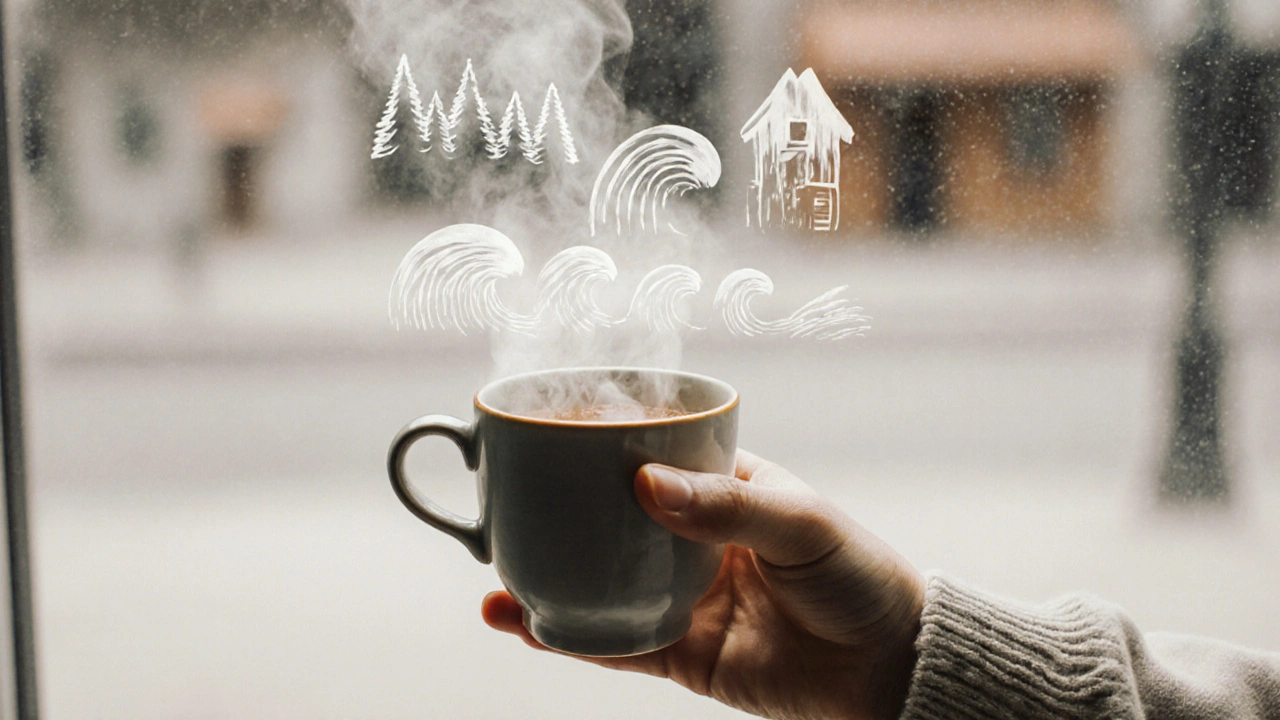Stress doesn’t vanish when you wish it away. It lingers in your shoulders, tightens your jaw, and turns quiet nights into endless loops of worry. You don’t need a week off or a spa retreat to reset. Sometimes, all it takes is ten minutes and one simple technique to shift your nervous system from fight-or-flight to rest-and-digest. The best part? These tools work whether you’re at your desk, waiting in line, or lying in bed with your eyes wide open.
Deep Breathing: Your Instant Calm Button
Deep breathing isn’t just for yoga classes. It’s a biological hack. When you slow your breath to about four seconds in, four seconds hold, six seconds out, you activate the vagus nerve-the main wire connecting your brain to your heart and gut. This tells your body: "We’re safe now."
Try this right now: Place one hand on your belly. Breathe in slowly through your nose, letting your stomach rise like a balloon. Exhale through your mouth, letting it fall. Do this for just three cycles. Notice how your shoulders drop, your thoughts slow. That’s your nervous system resetting. No apps, no candles, no special seat needed.
Progressive Muscle Relaxation: Release Tension from the Inside Out
Most people carry stress as physical tension-clenched fists, tight necks, locked jaws-without even realizing it. Progressive muscle relaxation (PMR) teaches you to feel that tension so you can let it go.
Start with your feet. Tighten the muscles there as hard as you can for five seconds. Then, suddenly release. Feel the warmth, the heaviness, the quiet. Move up: calves, thighs, glutes, abdomen, hands, arms, shoulders, face. Hold each tension for five seconds, then release. Do this from head to toe, and you’ll feel like you’ve shed a heavy coat. Studies from the American Psychological Association show PMR reduces cortisol levels and improves sleep quality in people with chronic stress.
Guided Imagery: Escape to a Calm Place (Without Leaving Your Chair)
Your brain doesn’t distinguish much between real and imagined experiences. That’s why guided imagery works. Close your eyes and picture a place that makes you feel safe and still-maybe a beach at sunrise, a forest after rain, or a cozy cabin with a fire.
Engage all your senses. What do you hear? Birds? Waves? Crackling wood? What do you smell? Salt air? Pine? Burning cedar? Feel the temperature. Is the air cool? Is the sun warm on your skin? Spend five minutes here. When your mind wanders (it will), gently bring it back. This isn’t meditation. It’s mental travel. And it’s proven to lower heart rate and blood pressure in clinical settings.
Box Breathing: The Navy SEALs’ Secret for Calm Under Pressure
Used by military personnel, firefighters, and athletes, box breathing is simple but powerful. Inhale for four counts. Hold for four. Exhale for four. Hold for four. Repeat.
It’s called "box" because you trace the sides of a square with your breath. This rhythm overrides the chaotic signals your brain sends when you’re overwhelmed. Try it before a tough conversation, after a bad email, or when you’re stuck in traffic. It takes less than a minute and gives you back control. No one needs to know you’re doing it.

5-4-3-2-1 Grounding: Stop the Spiral Before It Starts
Anxiety often pulls you into your thoughts-worries about tomorrow, regrets from yesterday. Grounding snaps you back to the present. The 5-4-3-2-1 method uses your senses to anchor you.
Find five things you can see: a lamp, a book, a crack in the wall, your coffee mug, a plant. Four things you can touch: your shirt fabric, the chair arm, your keys, your own cheek. Three things you can hear: distant traffic, the hum of the fridge, your breath. Two things you can smell: soap, laundry detergent, or even just the air. One thing you can taste: your toothpaste, a sip of water, or nothing at all.
This technique is used in trauma therapy for a reason. It works fast. And it’s hard to panic when you’re actively noticing the texture of your socks.
Listening to Binaural Beats: Let Sound Reset Your Brainwaves
Binaural beats aren’t magic. They’re science. Play two slightly different tones-one in each ear-through headphones. Your brain picks up the difference and synchronizes its own frequency to match. For relaxation, aim for theta waves (4-8 Hz), which are linked to deep calm and creativity.
Try a 10-minute session before bed or during lunch. You don’t need expensive gear. Free apps like Brain.fm or Insight Timer offer tested tracks. Some people feel nothing. Others report sudden calm, like a switch flipped. Give it three tries. If it doesn’t click, move on. But if it does? You’ve found a silent tool you can use anytime.
Warm Tea Ritual: Slow Down with Sip-by-Sip Awareness
Drinking tea isn’t just about caffeine or herbs. It’s about ritual. Boil water. Pour it slowly. Watch the leaves unfurl. Smell the steam. Feel the warmth of the cup in your hands. Sip. Don’t gulp. Let the flavor unfold. Pause between sips.
This isn’t tea as fuel. It’s tea as mindfulness. Chamomile, peppermint, or rooibos work best-no caffeine, no rush. A 2022 study in the journal Psychopharmacology found that participants who practiced mindful tea drinking reported lower stress levels after just one week. It’s not the tea. It’s the attention.

Walking Without a Destination: Move Your Body, Quiet Your Mind
You don’t need to walk for fitness. Walk to unwind. Put on your shoes. Step outside. Don’t check your phone. Don’t plan your evening. Just walk. Notice the sky. The way light hits the pavement. The sound of your footsteps. The breeze on your skin.
Even five minutes of this-no destination, no pace, no goal-can reduce rumination (that loop of overthinking). Research from Stanford University found that people who walked in nature, even urban parks, showed decreased activity in the brain region linked to negative thoughts. You don’t need a trail. A sidewalk works.
Journaling for Release: Get the Noise Out of Your Head
Write down everything swirling in your mind. Not to fix it. Not to make sense of it. Just to get it out. Use a notebook. Scribble. Use a phone app. Type in all caps. No grammar. No structure. Just dump it.
This isn’t diary writing. It’s mental decluttering. A 2018 study in the Journal of Clinical Psychology showed that people who wrote about their emotions for 15 minutes a day, three times a week, reported lower anxiety and better sleep within four weeks. Your brain stops trying to hold onto the thoughts once they’re on paper. It’s like hitting delete on a file you didn’t know was clogging your system.
Body Scan Meditation: Reconnect with Yourself, One Part at a Time
Body scan meditation is like a gentle tour of your physical self. Lie down. Close your eyes. Bring your attention to your toes. Notice any sensation-tingling, warmth, numbness, nothing at all. Don’t try to change it. Just observe. Slowly move up: feet, ankles, calves, knees, thighs, hips, belly, chest, arms, hands, neck, face, scalp.
It takes 10 to 15 minutes. You don’t have to do it perfectly. If your mind drifts to your to-do list, that’s normal. Gently return to the body. This practice is used in mindfulness-based stress reduction (MBSR) programs and has been shown to reduce symptoms of chronic pain, insomnia, and anxiety. You’re not fixing anything. You’re just being with yourself.
Final Thought: You Don’t Need to Do Them All
These aren’t chores. They’re options. Try one this week. Then another next week. Notice which one makes your shoulders drop the fastest. Which one you come back to when things feel heavy. That’s your tool. That’s your reset.
Relaxation isn’t about achieving perfect calm. It’s about remembering you can return to stillness-even when the world is loud.
How long should I practice each relaxation technique?
You don’t need long sessions to benefit. Even 2 to 5 minutes of deep breathing, grounding, or body scan can shift your nervous system. For techniques like progressive muscle relaxation or guided imagery, 10 to 15 minutes is ideal if you can spare it. Consistency matters more than duration. Doing a 3-minute technique daily is more effective than a 30-minute session once a week.
Can relaxation techniques replace therapy or medication?
No. Relaxation techniques are powerful tools for managing everyday stress, improving sleep, and building resilience. But they are not substitutes for professional mental health care. If you’re dealing with clinical anxiety, depression, PTSD, or chronic stress that interferes with daily life, talk to a licensed therapist or doctor. These techniques work best as part of a broader plan-not as a standalone cure.
What if I can’t focus during meditation or breathing exercises?
That’s normal. Everyone’s mind wanders-even experienced practitioners. The goal isn’t to stop thoughts. It’s to notice when you’ve drifted and gently return. Each time you bring your focus back, you’re strengthening your attention muscle. Think of it like lifting weights: the effort is the exercise. Don’t judge yourself. Just keep showing up.
Which technique works best for nighttime anxiety?
Body scan meditation and progressive muscle relaxation are the most effective for nighttime anxiety. Both help quiet mental chatter by shifting focus to physical sensations. Pair them with warm tea and dim lighting. Avoid screens for at least 30 minutes before bed. Many people report falling asleep faster after a 10-minute body scan, even if they started out wide awake.
Do I need special equipment or apps?
No. Everything here can be done with just your body and your breath. Apps and binaural beats can help guide you, especially at first, but they’re not required. A quiet space and five minutes are all you need. The most effective tools are the ones you can use without buying anything.
Why do some techniques work for me but not others?
Everyone’s nervous system responds differently. Some people feel calm through movement (like walking), others through stillness (like body scans). Some need sound (binaural beats), others need words (guided imagery). It’s not about finding the "best" technique-it’s about finding the one that fits your brain and your life right now. Try them all, then let go of the ones that don’t click.





